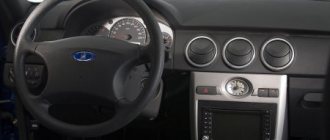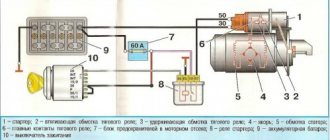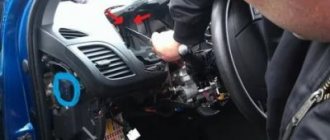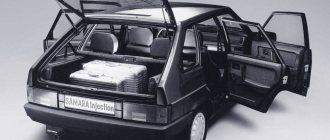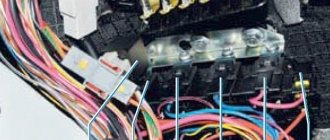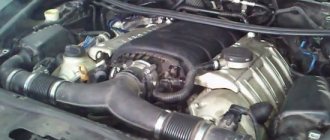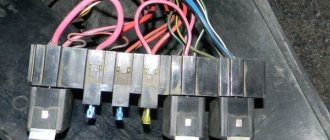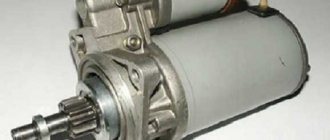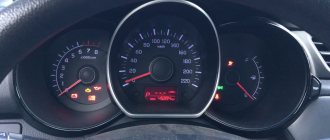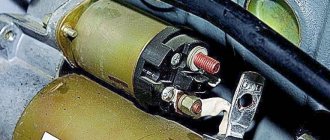To properly start an internal combustion engine, it is necessary to have a prepared fuel-air mixture, in the correct proportion, in the cylinders, which is ignited by a spark from the spark plug at a strictly defined moment.
In addition, all parts and components associated with the starter/ignition switch must be in good working order. Lada Largus may experience problems when starting the internal combustion engine if some elements of the system are broken or not working correctly.
Lada Largus does not start, the starter turns
To start a car engine, it is necessary to have a spark and a fuel mixture in the cylinders at the right time. Problems with starting the Lada Largus engine may occur if one or more elements of the vehicle systems fail. This article lists the reasons and solutions for cases where the starter turns, but the engine does not start.
| Possible malfunction | Diagnostics | Remedies |
| There is no gasoline in the tank | On the instrument cluster the fuel level arrow is at zero. | Pour gasoline |
| Battery is low | The voltage at the battery terminals with consumers turned off is less than 12V. When trying to start the engine, a cracking noise is heard from under the hood. | Charge the battery or replace it with a new one |
| Oxidation of battery terminals or wire terminals, their fit is not tight | When you try to start the car, the voltage in the on-board network drops much more than at the battery terminals. In this case, a crash may be heard under the hood. | Clean the contacts, lubricate them with petroleum jelly and tighten the terminals |
| Unreliable connection of electrical circuits of engine control and power supply systems | Check the connections of the connectors and the reliability of the contacts in the blocks. | Fix faulty wire connections |
| Increased resistance to rotation of the crankshaft (scores on the shafts, bearing shells, cylinder-piston parts, deformation of the shafts, frozen engine oil, jammed generator, jammed coolant pump) | The crankshaft turns slowly. If the engine is started in severe frost, and the engine was working properly the day before, then most likely the engine oil has frozen. If you hear extraneous noise when starting the engine, check the free rotation of the pump and generator pulleys. | Use the recommended engine oil. Repair the engine. Replace the pump and generator. |
| Malfunction in the ignition system | Check for spark. | Check the circuits and devices of the ignition system. Replace faulty system elements. |
| HV wires are connected in the wrong order or the wire is disconnected (on K7M engine) | Inspect. | Connect the wires in the correct order |
| The timing belt is broken or the belt teeth are cut off | Open the front timing cover and check. | Replace timing belt |
| Disturbed valve timing | Check the marks on the crankshaft and camshaft pulleys. | Set the correct shaft position |
| Malfunction of the ECU (electronic engine control unit), its circuits, crankshaft position sensor or coolant temperature | Check the supply of +12V to the ECU, the sensor circuit, and the absence of damage to the sensors themselves. | Replace ECU, sensors. |
| The idle air regulator (IAC) or its circuits are faulty | Check IAC. When starting the engine, lightly press the gas pedal. If the car starts and stalls when you release the gas pedal, then the sensor is faulty. | Replace sensor |
| The fuse is blown or the main relay of the control system is faulty | Check fuse and relay. | Eliminate the cause of the blown fuse. Replace fuse and relay |
| Fuse blown, fuel pump relay. Circuit, relay or pump is faulty. | When the ignition is turned on, there is no sound of the pump running. Check the fuse. Apply voltage to the pump from the battery. | Clean contacts, replace faulty circuits, replace fuse, pump and relay. |
| The fuel filter is dirty, the water in the fuel line is frozen, the fuel line is damaged | Check the pressure in the fuel rail and the condition of the fuel lines. | Replace the filter, blow out or replace the fuel lines. |
| Insufficient pressure in the fuel rail | Check the pressure in the fuel rail, the pump strainer and the condition of the fuel lines. | Clean the filter. Replace the pump, fuel pressure regulator (RDT) |
| Faulty injectors or their power supply circuits | Check the injector windings with an ohmmeter. Check the chains for breaks. | Replace injectors, replace chains |
| Air leak into the intake tract | Inspect the joints and fittings of the hoses and clamps. During start-up, turn off the vacuum brake booster (VUT) and plug the receiver fitting. | Eliminate air leaks, replace vacuum booster |
Lada Largus starts and immediately stalls:
- Ignition coil electrical connections are loose or damaged.
- Insufficient pressure in the fuel rail.
- The connections of the intake tract parts are leaking (catalytic manifold or intake manifold receiver).
- The engine control system is faulty. Run diagnostics.
Lada Largus does not start when cold:
- If the crankshaft rotates slowly, the battery may be discharged or the engine oil may be frozen.
- The water in the fuel rail has frozen.
- The coolant temperature sensor (DTOZH) of the engine management system is faulty.
- Fuel injectors are leaking.
- Low compression in cylinders.
- The engine control system is faulty. Run diagnostics.
Let us remind you that regular vehicle maintenance will help eliminate engine starting problems.
Source
Alternative ways to start the engine
You can start a car with problems in the starter/ignition switch system by towing or using a pusher. To do this, you need to turn on the ignition, depress the clutch with the gearbox in second gear, accelerate the car to a speed of 10-15 km/h and release the clutch. If the engine starts, turn off the gear and stop smoothly.
There are situations when it is not possible to push the car to the required speed. In this situation, if the problem is not in the starter winding or jamming of its elements, you can start the car simply by short-circuiting the contacts with a screwdriver or a large wrench. To do this, you need to turn on the ignition and turn off the gearbox. Next, find the starter under the hood, remove the protective rubber casing from the wires and close two large opposite contacts. After the engine starts, open the indicated contacts.
Such actions must be carried out after making sure of your own safety and the safety of others.
Lada Largus won't start
Lada Largus (2019). The starter turns, but the engine does not start
There can be quite a few reasons for this behavior of a car. The main ones are listed below
Human factor
: You forgot to turn off the anti-theft, which blocks, for example, only the fuel pump. The exhaust pipe is clogged. Kind people put a rag or a potato in it, or maybe you just drove into a snowdrift - there are many options. The exhaust pipe must be freed.
All of the above, in general, is not a breakdown, and can be solved in no time. Now let’s look at the reasons associated with a technical malfunction: If the starter turns very slowly, then the cause may be the oil in the engine that has thickened in the cold. Or maybe it’s a discharged battery after a long stay or its terminals are heavily oxidized. In this case, the voltage of the on-board network may drop so much that the engine control unit refuses to work. Well, everything is clear here: the oil should be filled according to the season, the battery should be charged or replaced. Something has frozen - water in the gas line, diesel fuel in the tank or filter. Look for a warm box! The fuel pump is faulty. This is easy to verify, unless you are trying to start the car near a busy and noisy highway. If the environment is quiet, then a sensitive ear can detect the absence of the characteristic buzzing of the fuel pump during starter operation. In the best case, poor contact in the circuit is to blame; in the worst case, you will have to replace the pump. The flywheel crown rotates. This sometimes happened on cars of previous years, up to the VAZ-2109. You can hear that the Bendix is engaged with the ring, and the ring rotates on the flywheel with a squeal. The flywheel is about to be replaced.
The starter does not engage with the ring
. Reason: wear of parts, chipped teeth, etc. When you try to start, you hear grinding teeth. Get ready to replace the ring gear or flywheel.
Bendix stuck
. Whether its drive failed, or the Bendix itself, it doesn’t matter. You can hear the starter motor spinning at high speeds, but there is no further attempt to crank the engine. Get ready to repair or replace the starter itself.
Failure of the ignition system in gasoline cars
. We check everything - spark plugs, coils, wiring, etc. The glow plugs of a diesel car do not work. The problem may be in the control unit, as well as in the power relay. The candles themselves should also be checked - you will have to tinker with this.
Timing belt shattered
. It’s easy to feel: it’s easy for the starter to turn. If you're lucky (the pistons don't meet the valves), it's enough to replace the belt; if not, then half the engine.
The timing belt jumped several teeth, disrupting the correct valve timing. Again, in the best case, you will need to return the belt to its place, but in the worst case, you will face expensive repairs. Increased resistance to rotation of the crankshaft: scuffing on shafts, bearing shells, parts of the cylinder-piston group, deformation of shafts. Check if the engine can be cranked when pushing the vehicle with the manual transmission in top gear. With an automatic transmission, you will have to try to turn the engine using the bolt securing the auxiliary drive pulley. If the engine can be turned over relatively easily, then the search for the cause will need to be continued.
Air leaks as a cause of floating speed
Many owners note that in the morning, especially in winter, after starting the engine, the engine is unstable, the speed jumps and the car begins to twitch while driving. They look for a problem in the immobilizer or spark plugs, but if the diagnostics do not reveal problems, the problem is in the throttle body.
The malfunction is an air leak due to a loose connection between the throttle valve and the intake receiver. The problem is solved by replacing the o-ring with a similar new one or changing the design using adhesive tape. Procedure for replacing the ring:
- throttle cable disconnected;
- the rubber band securing the inlet pipe is removed;
- The plastic intake muffler has been removed;
- the power plug is disconnected from the IAC and throttle position sensor;
- the air filter mounting bolts are unscrewed;
- the throttle valve bolts are unscrewed;
- The old ring is removed and a new one is put on.
Then everything is put back together and tested for functionality.
The process of replacing the throttle valve O-ring takes a maximum of half an hour.
Although the engines were borrowed from well-known Renault models, they migrated under the hood of the VAZ Largus along with typical faults. However, you can fix the problem of mobile device inactivity yourself. If you lack confidence and experience, your best bet is to go to a gas station.
Tool:
- 10 mm spanner
- 13 mm spanner
- Multitester
- Final Attack Collar
- Key end extension
- 8 mm key attack
- Key connection 10 mm
- 13mm key attack
- Medium flathead screwdriver
- Fixed charger
- Pliers
Spare parts and consumables:
- Vaseline technical VTV-1 in aerosol packaging
- Sandpaper with a grain size of no more than P220 or felt with PMA-2 abrasive paste
- Starting system contact connections
- Egnition lock
- Starter traction relay
- They're flying
- Starter drive
Notes:
To confirm a malfunction of the engine starting system, the following deviations in the operation of other mechanisms are necessary, which can be seen by performing a series of actions described below.
1. When diagnosing the cause of abnormal engine starting, open the car door and watch how the brightness of the interior lighting lamps changes.
Note:
The brightness of the lighting lamp depends on its supply voltage. During normal starter operation, the interior lighting is slightly dimmed.
If the brightness of the lighting does not change, then the cause of the problem is usually an open circuit in the starting system control circuit.
If the lights go out almost or completely, the cause of the problem is most likely a short circuit or ground fault in the starter field windings or a faulty battery.
2. Do not knock on the starter as this may damage the starter parts.
Note:
In the past, it was not uncommon to see a technician pressing the starter while trying to figure out why it wasn't working. Often, shock loading would cause the commutator brushes, rotor, and bearing shells to align or move. In many cases, after using the starter, its performance was restored, although not for long.
But most modern starters use permanent magnets, which are fragile and can break if impacted. A broken magnet splits into several weak magnets. Some early permanent magnet starter designs had the magnets glued to the stator housing. With a strong blow to the starter, these magnets crumbled into pieces, which, hitting the rotor or bearing seats, led to complete destruction of the starter.
Causes and methods of troubleshooting the starting system.
The starter does not turn on
1. Defective battery - check the battery.
2. Oxidation of battery terminals and tips. Clean, secure, and lubricate the lugs and terminals with Vaseline as described in this article.
3. Broken contacts in the connections, broken wires in the starter power and control circuits: check, clean, tighten or replace the contact connections in the starter control and power circuits.
4. Malfunction of the ignition switch (lock) - replace the contact group of the ignition switch (lock).
5. The traction relay is faulty - replace the traction relay.
6. Faulty starter: Repair the starter by removing it as described here.
The traction relay is activated, but the starter armature does not rotate or rotates too slowly.
1. Battery is low: Charge or replace the battery.
2. Oxidation of battery terminals and cable ends. Strip, secure and lubricate the cable ends and terminals with Vaseline.
3. Loosely tighten the nuts securing the lugs to the traction relay terminals - tighten the nuts with wrenches.
4. Faulty starter: Repair the starter by removing it as described here.
The traction relay turns on and off immediately (frequent knocking)
1. Battery charge is very low: charge with a stationary charger or replace the battery.
2. Increased starter power circuit resistance - strip and secure cable lugs. Replace faulty cables.
3. The ignition switch (lock) is faulty - replace the ignition switch contact group (lock.
4. The traction relay is faulty - replace the traction relay.
The starter turns on, but the crankshaft does not rotate
Faulty Starter: Repair the starter by removing it as described here.
The starter turns on, but the gear does not engage
Nickel teeth on drive gear or flywheel rim - Remove teeth or replace flywheel or starter drive.
The starter does not turn off after starting the engine
1. The key is stuck in the ignition switch in position “D” - repair or replace the mechanical part of the ignition switch (lock.
2. Closing the contacts of the ignition switch (lock) - replace the ignition switch (lock.
3. Faulty starter: Repair the starter by removing it as described here.
Increased noise level when rotating the starter armature
1. Loose starter assembly: Tighten the starter mounting bolts.
2. The teeth of the starter drive gear or the flywheel ring gear are damaged - replace or repair the starter, replace the flywheel.
3. Faulty starter: Repair the starter by removing it as described here.
Article missing:
- Tool image
- Photos of parts and consumables
To properly start an internal combustion engine, it is necessary to have a prepared air-fuel mixture in the cylinders in the correct proportion, which is ignited by a spark from the spark plug at a strictly defined moment.
Additionally, all parts and components connected to the starter/ignition switch must be in good working order. The Lada Largus may have problems starting the internal combustion engine if some elements of the system are broken or do not work properly.
ATTENTION! I found a completely simple way to reduce fuel consumption! You do not believe me? Even a mechanic with 15 years of experience didn’t believe it until he tried it. Now save 35,000 rubles a year on gasoline! Know more"
Largus will not start, help me make a diagnosis.
Theme Options
Search by topic
Largus will not start, help me make a diagnosis.
Good afternoon, forum members, I’ve encountered a problem that I can’t solve myself (I’ve been studying similar cases on the Internet for 3 days now - to no avail), I’m asking for help, can anyone advise me.
Actually it is given: Lada Largus 2013 (I took a new one) 7-seater, 16-valve engine - K4M, mileage 57,000 km, all maintenance was done on time, the car was used carefully. The following happened: I left it running and with the high beams on, PTF (I was working in the headlights myself) and the interior blowing, after 20-30 minutes I come back, the engine doesn’t work (but it stalled recently - it hasn’t cooled down), I try to start the starter, the engine turns, doesn’t pick up, doesn’t sneezes and spins very quietly, but quickly. I thought it might be a retractor, just in case I checked it - the engine was turning (put it in gear and turned the key - it jerked). What I did next: 1) I removed the terminals from the battery (I thought maybe there was some mistake) and after waiting 5-8 minutes I connected it back. 2) We tried to start it with a pusher. 3) I checked the fuel pump (it sounds like it works when the key is first turned); just in case, the fireman got to the fuel pump itself, removed the hose and, putting the key back in the preliminary position, witnessed a vigorous stream of gasoline. . (further dancing with a tambourine 140 km from home, at 2 am it was decided to finish and get home by tow truck) the search continued in the morning. 4) I tried the spare key (immobilizer) 5) I checked all the fuses, both in the passenger compartment and in the engine compartment (visually without a “continuity”), I also pulled out each relay, examined it and stuck it in place 6) I tried to get the crankshaft sensor, according to I made a mistake and unscrewed the coolant temperature sensor, which I was very unhappy about (I filled everything with antifreeze
